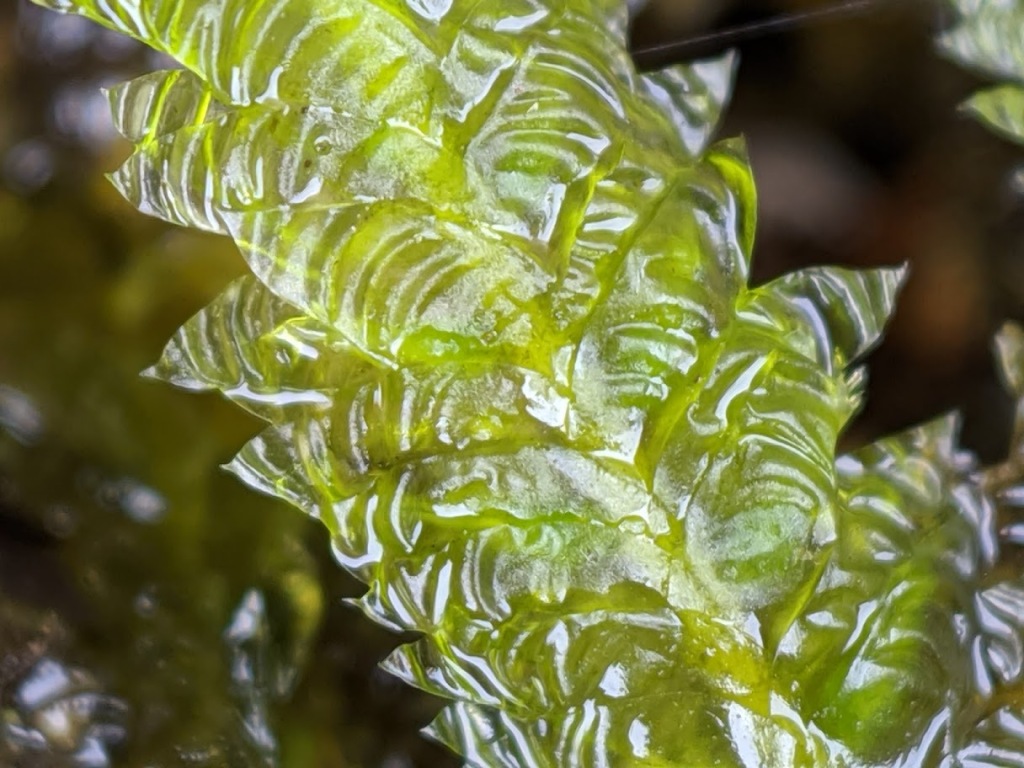Neckeraceae
Autoicous, synoicous (not in Victoria), polyoicous (not in Victoria) or dioicous. Asexual reproduction by caducous flagelliform branchlets (not in Victoria) or branch leaves (not in Victoria). Wefts, dense mats or gregarious, often glossy, on rocks, trees or soil, sometimes aquatic. Stems differentiated into a primary creeping stem and secondary stems that are often perpendicular to substrate; primary stems usually with smaller leaves or rarely leafless, with tufts of rhizoids below leaf insertions; secondary stems simple, branched throughout or with a basal unbranched stipe section below a branched frond section, irregularly or pinnately to bipinnately branched, without rhizoids or rhizoids restricted to apices in contact with substrate; paraphyllia present and foliose or filiform, or absent; pseudoparaphyllia filamentous or foliose; central strand absent or present. Leaves usually complanate, sometimes arranged around stem and facing all directions, monomorphic, dimorphic with lateral leaves differing from dorsal leaves by the position of the costa, or branch leaves sometimes smaller than stem leaves, erect to squarrose when moist, scarcely altered or becoming more erect or appressed when dry, often imbricate, symmetric or asymmetric, sometimes distinctly undulate, decurrent or not; apex rounded, obtuse, apiculate (not in Victoria), acute, acuminate or subulate; costa single and terminating in basal to apical half, subpercurrent, short and double, or absent; margin entire or crenulate to serrate toward apex, reflexed, incurved or plane, without a distinct border or rarely with a intramarginal border of more elongated cells (not in Victoria); laminal cells quadrate, elliptic, rhomboid, rectangular or linear, shorter and quadrate to rectangular near margin, often longer toward base, smooth or rarely papillose (not in Victoria); alar cells weakly differentiated and oblate to quadrate, or not differentiated. Pleurocarpous. Capsules erect to horizontal, symmetric, immersed to exserted, operculate, with or without an annulus. Calyptra cucullate, smooth, hairy or glabrous. Operculum conic or rostrate. Peristome double and alternate or reduced and single; exostome of 16 entire teeth; endostome rudimentary or absent, or of 16 segments, with a high or low basal membrane; cilia present or absent.
Worldwide except Antarctica, with around 34 genera and 210 species; four genera and species in Victoria.
The families Leptodontaceae and Thamnobryaceae have been shown to have evolved from Neckeraceae ancestors based on phylogenies of DNA sequences from all genomic compartments and so these families have been returned to Neckeraceae (Olsson et al. 2009, 2011, 2016; Enroth et al. 2019; Fedosov & Ignatov 2019), where they were previously placed by Brotherus (1925). The Victorian Echinodiopsis hispida was previously misplaced in Echinodium in the Echinodiaceae (e.g. Stech et al. 2008; Gilmore 2012) as phylogenies of DNA sequences clearly show that this species and the former Echinodium umbrosus that now form Echinodiopsis, belong to the Neckeraceae (Stech et al. 2008; Olsson et al. 2010, 2011; Enroth et al. 2019). Under this broader circumscription of the Neckeraceae the family is defined by having leaves with at least one or two marginal rows of cells that are quadrate to rectangular and shorter than inner laminal cells, a consistent lack in dwarf males, and the leaves are usually complanately arranged (Olsson et al. 2009). Other features prevalent in the family are smooth laminal cells, creeping primary stems with smaller leaves and tufts of rhizoids below leaf insertions, and frondose secondary stems (Olsson et al. 2011).
 Spinning
SpinningEnroth, J.; Olsson, S.; Huttunen, S.; Buchbender, V.; Tangney, R.; Stech, M.; Hedenäs, L.; Quandt, D. (2019). Orthostichellaceae fam. Nov. and other novelties in pleurocarpous mosses revealed by phylogenetic analyses. The Bryologist 122: 219–245.
Fedosov, V.E.; Ignatov, M.S. (2019). Enrothia, a new genus of Neckeraceae (Bryophyta) from east Asia. Arctoa 28: 12–17.
Gilmore, S.R. (2012). Australian Mosses Online 10. Echinodiaceae. Version 19 April 2012. Australian Biological Resources Study, Canberra.
Olsson, S.; Buchbender, V.; Enroth, J.; Hedenäs, L.; Huttunen, S.; Quandt, D. (2010). Phylogenetic relationships in the ‘Pinnatella’ clade. Organisms Diversity and Evolution 10: 107–122.
Olsson, S.; Buchbender, V.; Enroth, J.; Huttunen, S.; Hedenäs, L.; Quandt, D. (2009). Evolution of the Neckeraceae (Bryophyta): resolving the backbone phylogeny. Systematics and Biodiversity 7: 419–432.
Olsson, S.; Enroth, J.; Buchbender, V.; Hedenäs, L.; Huttunen, S.; Quandt, D. (2011). Neckera and Thamnobryum (Neckeraceae, Bryopsida): Paraphyletic assemblages. Taxon 60: 36–50.
Olsson, S; Enroth, J.; Huttunen, S.; Quandt, D. (2016). Phylogeny of Neckeropsis and Himantocladium (Neckeraceae, Bryophytina) . Bryophyte Diversity & Evolution 38: 53–70.
Stech, M.; Sim-Sim, M.; Esquível, M.G.; Fontinha, S.; Tangney, R.; Lobo, C.; Gabriel, R.; Quandt, D. (2008). Explaining the ‘anomalous’ distribution of Echinodium (Bryopsida: Echinodiaceae): Independent evolution in Macaronesia and Australasia. Organisms Diversity & Evolution 8: 282–292.


